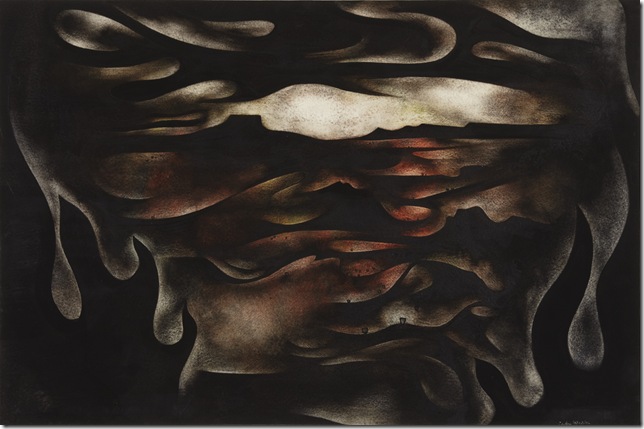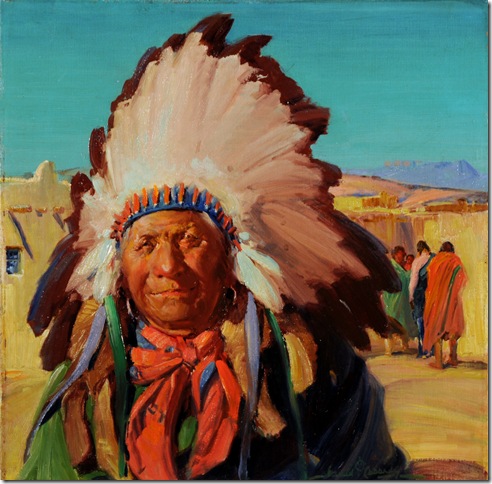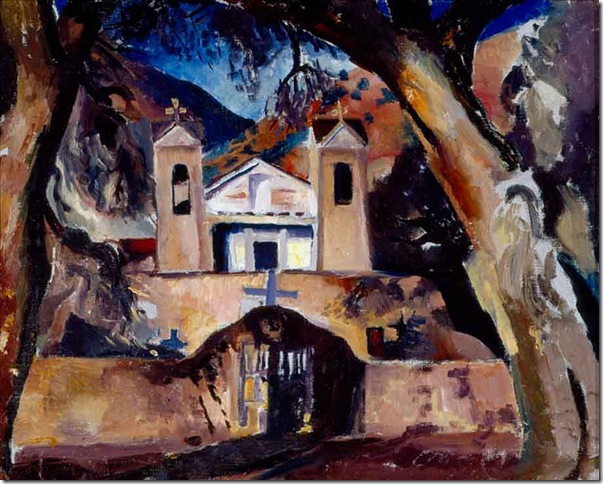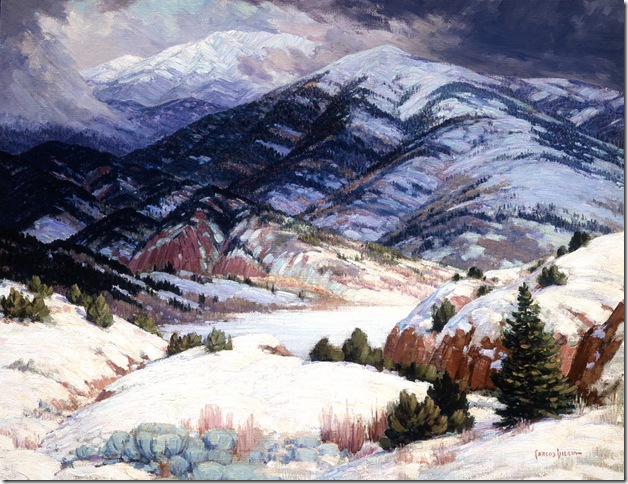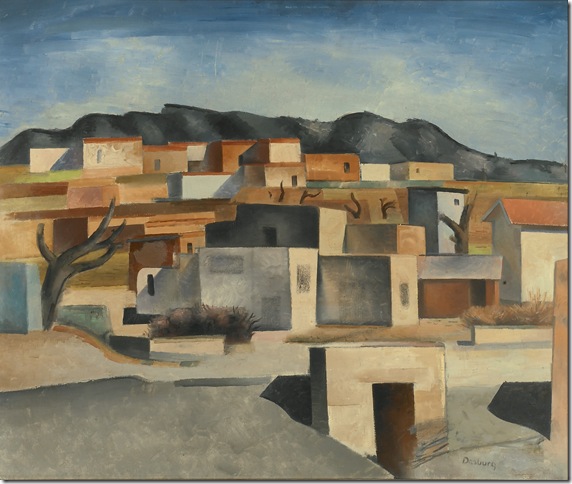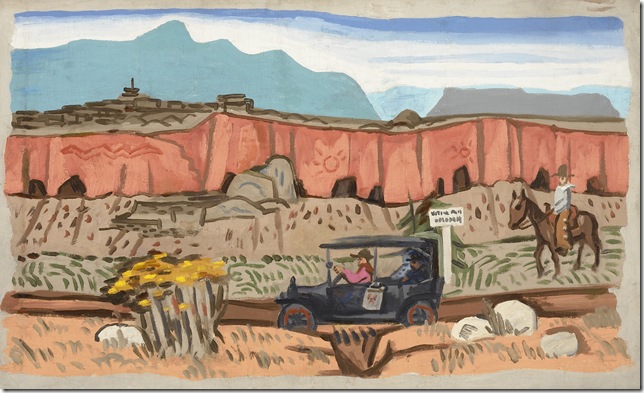A mountain can be round and painted in warm, earthy tones or triangular, in dark blues and greens, or malleable, sporting a rosy fleshy hue or stiff in teal and gray. The unexplored isolated region of Santa Fe turned out to be many different things to a group of artists looking for new inspiration away from the city lights.
Southwestern Allure: The Art of the Santa Fe Art Colony features artworks by artists who visited and settled in this New Mexico area from 1900 to 1938. They came looking for a drier climate, to recover from tuberculosis, out of mere curiosity or to escape the crowded city life. Most rediscovered themselves here and never left.
Among the 50-plus works on display at the Boca Museum of Art is a watercolor of soft, sandy tones by Kenneth Milton Chapman, who was one of the first visitors. Improvised households blend in with the natural landscape, which appears barely disturbed.
The small windows, wooden platforms and ladders let us know the elevation is actually home to local habitants. Some of them are hardly visible in the distance but very much present in the foreground, in the form of a girl wearing braids accompanying a donkey family. Chapman considered himself an “art-archaeologist” and, like many others, used art to document the region’s culture.
Homer Boss’s Santa Cruz Valley excels at depicting the variety of color, rock formation and atmosphere of the region. It is like looking at layers of beauty building up before our eyes. Where others saw a terracotta sea and dry land Boss saw greens, blues and grays.
A piece by Jozef G. Bakos interrupts the sequence of earthy, bone-color landscapes to introduce muddier colors, freer forms and loose ends. El Sanctuario de Chimayo features a place of worship bearing the symbol of the cross surrounded by trees in rich dark browns and greens. The fiery reds and dramatic vegetation is a departure from the cleaner, flatter compositions steps away. Here the trees are not just standing in the serene, immobile landscape. They seem to be readying for some sort of ceremony or sacrifice.
Bakos’s Upper Palace Avenue, Santa Fe, is also a little wild with its less defined shapes, splurges of colors to suggest clouds, vegetation and stormy sky. It is less dreamy than the rest of the works in display but equally enchanting. Later in the show, we find his recognizable color palate again in Rancho De Vallicitos, one of my favorites in the exhibit.
A white horse beautifully stands out against this seriousness of color. And something about the bold lines and the rich solid reds and browns bathing the wooden structures and the dark colors given to the hills speaks to Bakos’s respect for the Santa Fe landscape. It is as if he had wanted to give this place a more serious character than that depicted by fellow artists in the colony.
Santa Fe wears a different face in Northern New Mexico in Winter by Carlos Vierra. Tuberculosis led Vierra to leave New York in pursuit of drier climates. His is a picture of freezing temperatures, purples and blues. The light focuses on the white snowy beds on the ground. As we look up the picture gets darker, harsher and colder. The sky is changing before us.
Near Vierra’s is a singular work by Allen Tucker: San Ildefonso Pueblo. It features highly energetic brush work and thick paint. The artist here is not preoccupied with capturing the accuracy of the landscape but with feeling it. A gigantic cloud, the protagonist here, floats on and breathes as if it were alive. The tiny featureless figure to the left enhances the vast silence and isolation of the picture.
A more geometric approach by Andrew Dasburg greets us with Ranchos de Taos and Pueblo Village (New Mexico Village, Adobe Village). One gives us triangular mountains while the other features cube-like homes. The sense of depth is made possible by the bouncing shadows and the angle of the walls so that we are not looking at flat squares. Notice some of the structures face us from the right while others face us from the left.
More of this modernist tendency reappears at the end of the show with works by Raymond Jonson. The landscape in his edgy Earth Rhythms No.9 seems to erupt from the land instead of just sitting there. There are no loose ends here. No soft edges.
Passed the pictures featuring women of pronounced cheekbones and full lips, Indian chiefs, local rituals and titles like Macedonia, The Rain Prayer and Corn Dance is a work high in bright colors. The artist, Albert Krehbiel, is said to have been given a studio as a visiting artist in 1922 and 1923. Krehbiel followed the style of American Impressionism but with a much happier palate. His Noon Rest groups pinks and lemon greens with magentas and baby blues.
Pajarito Plateau by Stuart Davis is the flipping finger in the room. Every show has at least one work or one artist that abandons every art principle and value, everything taught by academics, to embrace the raw and unrefined. Davis gives us a teal mountain resembling a camel’s back, flat rock formations in bright coral. His short quick brushstrokes in green do for plants what stick figures do for the human form.
Before heading toward the darkest, introverted, most surrealist pieces of the exhibit, make sure to stop a while to contemplate Marsden Hartley’s Arroyo Hondo. Overwhelming in its simplicity and flatness, Arroyo combines minimalist composition and color use to deliver a stunning visual harmony. What seems at first to be one color taking over the canvas, slowly gives in to random touches of pink, white and purple.
Every art show has a certain attitude. Some make us feel uptight and stiff while others let us relax, put us at ease. Southwestern Allure, running through Dec. 29, could not be less pretentious. From the very beginning it gives us a warm welcome and makes us feel right at home. The feeling is probably the same felt decades ago by the artists on display, who painted out of a deep reverence for nature and the gratitude of having found a new home.
SOUTHWEST ALLURE runs through Dec. 29 at the Boca Raton Museum of Art in Mizner Park. Admission: $8 adults, $6 seniors, $4 students. Hours: 10 am-5 pm Tuesday, Thursday and Friday; 10 am-8 pm first Wednesday of the month; 12 pm-5 pm Saturday and Sunday. Closed Mondays and holidays. Call 561-392-2500, or visit www.bocamuseum.org.
